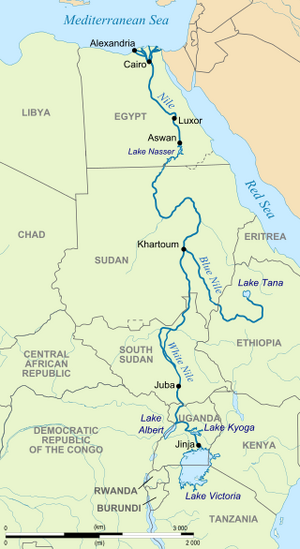Kenya

Kenya is an African country. Its capital and largest city is Nairobi.
Location
Kenya is located on the equator with the Indian Ocean lying to the south-east and is bordered by Tanzania to the south, Uganda to the west, South Sudan to the north-west, Ethiopia to the north and Somalia to the north-east.
Origin of name
The word Kenya originates from the Kamba name for Mount Kenya.
History
The first inhabitants of present-day Kenya were hunter-gatherer groups, akin to the modern Khoisan speakers.[1] These people were later replaced by agropastoralist Cushitic speakers from the Horn of Africa.[2] During the early Holocene, the regional climate shifted from dry to wetter climatic conditions, providing an opportunity for the development of cultural traditions, such as agriculture and herding, in a more favourable environment.
Around 500 BC, Nilotic speaking pastoralists (ancestral to Kenya's Nilotic speakers) started migrating from present-day Southern Sudan into Kenya.[3][4][5]
Nilotic groups in Kenya include the Samburu, Luo, Turkana, Maasai.[6]
By the first millennium AD, Bantu-speaking farmers had moved into the region.[7]
The Bantus originated in West Africa along the Benue River in what is now eastern Nigeria and western Cameroon.[8] The Bantu migration brought new developments in agriculture and iron working to the region.[9]
Bantu groups in Kenya include the Kikuyu, Luhya, Kamba, Kisii, Meru, Aembu, Ambeere, Wadawida-Watuweta, Wapokomo and Mijikenda among others.
Remarkable prehistoric sites in the interior of Kenya include the archaeoastronomical site Namoratunga on the west side of Lake Turkana and the walled settlement of ThimLich Ohinga in Migori County.
references
- ↑ Ehret, C. (2002) The Civilizations of Africa: a History to 1800, University Press of Virginia, ISBN 081392085X.
- ↑ Ehret, C. (1980) The historical reconstruction of Southern Cushitic phonology and vocabulary, Kölner Beiträge zur Afrikanistik 5, Bd., Reimer, Berlin.
- ↑ Ehret, C. (1983) Culture History in the Southern Sudan, J. Mack, P. Robertshaw, Eds., British Institute in Eastern Africa, Nairobi, pp. 19–48, ISBN 1872566049.
- ↑ Ambrose, S.H. (1982). "Archaeological and linguistic reconstructions of history in East Africa." In Ehert, C., and Posnansky, M. (eds.), The archaeological and linguistic reconstruction of African history, University of California Press, ISBN 0520045939.
- ↑ Ambrose, S.H. (1986) Sprache und Geschichte in Afrika 7.2, 11.
- ↑ International Labour Office, Traditional occupations of indigenous and tribal peoples: emerging trends. International Labour Organization (2000), p. 55, ISBN 9221122581.
- ↑ Ehret, C. (1998) An African Classical Age : Eastern and Southern Africa in World History, 1000 B.C. to A.D. 400., University Press of Virginia, Charlottesville, pp. xvii, 354, ISBN 0813920574.
- ↑ Smith, C. Wayne (1995) Crop Production: Evolution, History, and Technology, John Wiley & Sons, p. 132, ISBN 0471079723.
- ↑ Smith, C. Wayne (1995) Crop Production: Evolution, History, and Technology, John Wiley & Sons, p. 132, ISBN 0471079723.

